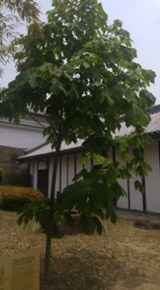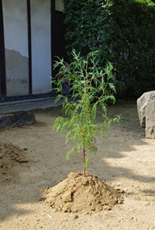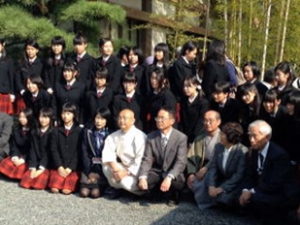The planted A-bombed Aogiri in Nijo Castle
Yoshie Doi
 |
 |
 |
A-bombed Aogiri II tree planting and commemorative photo, current Aogiri and commemorative photo
 |
 |
A commemorative photo with the cypress of His Majesty King Wangchuk of the Kingdom of Bhutan (with Aizu high school students)
It was raining that day. October 25, 2013, is the day when we planted the exposed Aogiri in Nijo Castle. It’s been nine years since then. I have visited Nijo Castle many times, but I visited there for the first time in a long time.
I was invited to a kimono exhibition in the tea room of Koun-tei. Whenever I visit Nijo Castle, I have something to check. It is to see the growth of the A-bombed Aogiri that was planted 9 years ago. The other is to see the subsequent growth of the national tree, cypress, which was given by His Majesty King Wangchuk of the Kingdom of Bhutan as a sacred tree for praying for overcoming the national crisis of the Great East Japan Earthquake. The two commemorative trees were planted by the members of Fukushima Prefectural Aizu High School, Kyoto City, the Bhutan Kingdom Exchange Association, and Kyo-Suzume.
With the meaning of sympathy and encouragement from the 2011 Great East Japan Earthquake, we welcomed the future messenger Aizu High School from the disaster area to Nijo Castle, the national tree cypress tree of the Kingdom of Bhutan, and let us plant a commemorative tree. I still remember it like yesterday.
Mr. Jikou Sato, the 10Th generation of Tyozennji temple, said, “He is in the position of the representative director of the Kyoto-Bhutan Kingdom Exchange Association, In addition, he was also the representative of the Kansai office of farm out A-bombed Aogiri movement, so it was realized.
At the ceremony to commemorate the planting of the national tree cypress tree, which was given by King Wanchuk, we received a message and said, “Kyoto is a place of memories, and we are celebrating the planting of cypress trees in this place.” Thank you for your thoughts.
When guiding visitors from overseas, we will always visit Nijo Castle. Two years ago, when I introduced the family of the ministers of a certain country, I was impressed by the splendor of the Ninomaru Palace, which coincided with the time of the cherry blossoms, and we were enthusiastically touring. Also, people from countries with a long history feel that their sense of the castle is more culturally and historically interested than the Japanese.
When you visit Nijo Castle, please take a look at A-bombed Aogiri. Trees are planted next to the office on the right after entering Nijo Castle. The cypress is in a place that cannot be seen by the general public because it is cured.
The end of document
